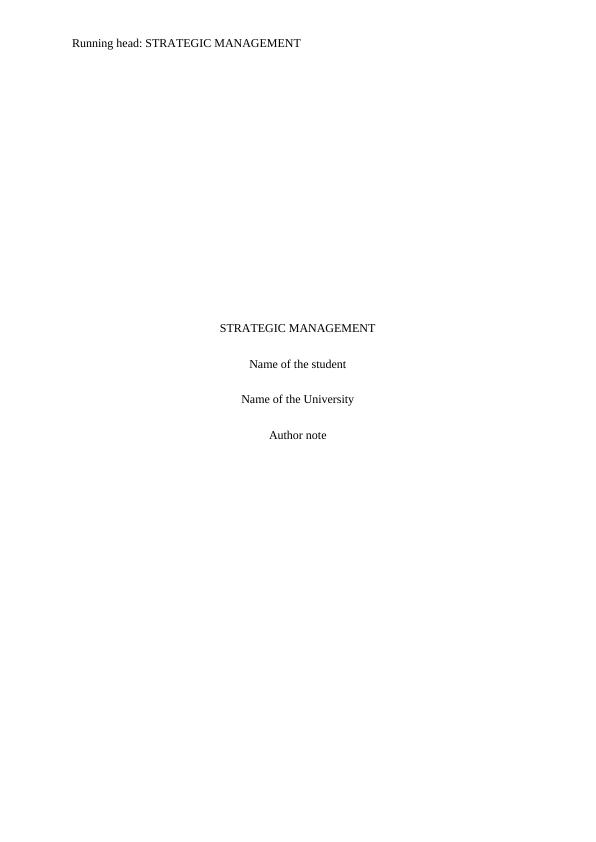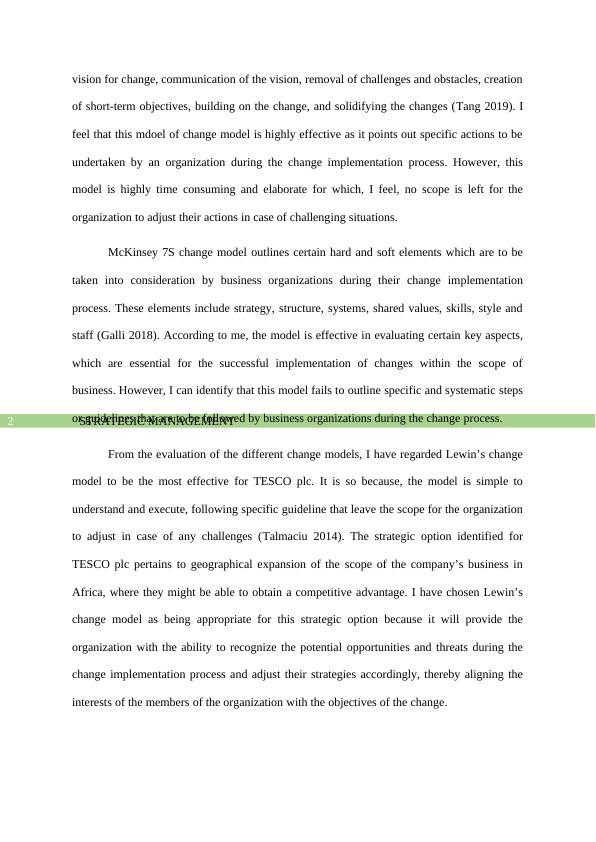THE STRATEGIC MANAGEMENT
Added on 2022-08-27
6 Pages1419 Words30 Views
Running head: STRATEGIC MANAGEMENT
STRATEGIC MANAGEMENT
Name of the student
Name of the University
Author note
STRATEGIC MANAGEMENT
Name of the student
Name of the University
Author note

STRATEGIC MANAGEMENT1
The changing environment of business organizations requires them to effectively
adapt and strategize their business policies and functions so as to be able to utilize the
opportunities available to them and tackle the challenges that may arise as a result of the
threats posed from the external environment (Shidane 2017). Change management is,
therefore, an essential process which involves the identification of the potential opportunities
and threats that will determine the growth and development of the business organization
(Cameron and Green 2019). There are several model of change management that may be
adopted by business organizations for effectively implementing changes that may bring about
increased productivity and profitability for them. Such change models may be identified to be
Kurt Lewin’s three step change model, Kotter’s eight step change model or McKinsey’s 7S
model.
Kurt Lewin’s change model provides a change implementation plan for business
organization in three simple steps. These steps are unfreezing, changing and refreezing.
According to me, the effectiveness of this change model is owing to its simplicity and
consideration of challenges that may arise in the change implementation process. The first
step of unfreezing pertains to the creation of an awareness among the members of the
organization regarding the need and purpose of implementing changes in the current business
operations or structure (Cummings, Bridgman and Brown 2016). The second step pertains to
actually making the desired changes within the scope of the organization and training the
employees so as to gather maximum participation and engagement. The third step of
refreezing pertains to stabilizing and solidifying the changes made in the previous process
through the alignment of the interests and activities of the members of the organization with
the objectives of change (Worley and Mohrman 2014).
Kotter’s 8 step model of change management involves the processes of creation of an
urgency for the change, formation of a guiding team using the change agents, creating a
The changing environment of business organizations requires them to effectively
adapt and strategize their business policies and functions so as to be able to utilize the
opportunities available to them and tackle the challenges that may arise as a result of the
threats posed from the external environment (Shidane 2017). Change management is,
therefore, an essential process which involves the identification of the potential opportunities
and threats that will determine the growth and development of the business organization
(Cameron and Green 2019). There are several model of change management that may be
adopted by business organizations for effectively implementing changes that may bring about
increased productivity and profitability for them. Such change models may be identified to be
Kurt Lewin’s three step change model, Kotter’s eight step change model or McKinsey’s 7S
model.
Kurt Lewin’s change model provides a change implementation plan for business
organization in three simple steps. These steps are unfreezing, changing and refreezing.
According to me, the effectiveness of this change model is owing to its simplicity and
consideration of challenges that may arise in the change implementation process. The first
step of unfreezing pertains to the creation of an awareness among the members of the
organization regarding the need and purpose of implementing changes in the current business
operations or structure (Cummings, Bridgman and Brown 2016). The second step pertains to
actually making the desired changes within the scope of the organization and training the
employees so as to gather maximum participation and engagement. The third step of
refreezing pertains to stabilizing and solidifying the changes made in the previous process
through the alignment of the interests and activities of the members of the organization with
the objectives of change (Worley and Mohrman 2014).
Kotter’s 8 step model of change management involves the processes of creation of an
urgency for the change, formation of a guiding team using the change agents, creating a

STRATEGIC MANAGEMENT2
vision for change, communication of the vision, removal of challenges and obstacles, creation
of short-term objectives, building on the change, and solidifying the changes (Tang 2019). I
feel that this mdoel of change model is highly effective as it points out specific actions to be
undertaken by an organization during the change implementation process. However, this
model is highly time consuming and elaborate for which, I feel, no scope is left for the
organization to adjust their actions in case of challenging situations.
McKinsey 7S change model outlines certain hard and soft elements which are to be
taken into consideration by business organizations during their change implementation
process. These elements include strategy, structure, systems, shared values, skills, style and
staff (Galli 2018). According to me, the model is effective in evaluating certain key aspects,
which are essential for the successful implementation of changes within the scope of
business. However, I can identify that this model fails to outline specific and systematic steps
or guidelines that are to be followed by business organizations during the change process.
From the evaluation of the different change models, I have regarded Lewin’s change
model to be the most effective for TESCO plc. It is so because, the model is simple to
understand and execute, following specific guideline that leave the scope for the organization
to adjust in case of any challenges (Talmaciu 2014). The strategic option identified for
TESCO plc pertains to geographical expansion of the scope of the company’s business in
Africa, where they might be able to obtain a competitive advantage. I have chosen Lewin’s
change model as being appropriate for this strategic option because it will provide the
organization with the ability to recognize the potential opportunities and threats during the
change implementation process and adjust their strategies accordingly, thereby aligning the
interests of the members of the organization with the objectives of the change.
vision for change, communication of the vision, removal of challenges and obstacles, creation
of short-term objectives, building on the change, and solidifying the changes (Tang 2019). I
feel that this mdoel of change model is highly effective as it points out specific actions to be
undertaken by an organization during the change implementation process. However, this
model is highly time consuming and elaborate for which, I feel, no scope is left for the
organization to adjust their actions in case of challenging situations.
McKinsey 7S change model outlines certain hard and soft elements which are to be
taken into consideration by business organizations during their change implementation
process. These elements include strategy, structure, systems, shared values, skills, style and
staff (Galli 2018). According to me, the model is effective in evaluating certain key aspects,
which are essential for the successful implementation of changes within the scope of
business. However, I can identify that this model fails to outline specific and systematic steps
or guidelines that are to be followed by business organizations during the change process.
From the evaluation of the different change models, I have regarded Lewin’s change
model to be the most effective for TESCO plc. It is so because, the model is simple to
understand and execute, following specific guideline that leave the scope for the organization
to adjust in case of any challenges (Talmaciu 2014). The strategic option identified for
TESCO plc pertains to geographical expansion of the scope of the company’s business in
Africa, where they might be able to obtain a competitive advantage. I have chosen Lewin’s
change model as being appropriate for this strategic option because it will provide the
organization with the ability to recognize the potential opportunities and threats during the
change implementation process and adjust their strategies accordingly, thereby aligning the
interests of the members of the organization with the objectives of the change.

End of preview
Want to access all the pages? Upload your documents or become a member.
Related Documents
Usefulness of Change Models in Samsunglg...
|5
|932
|85
Current Change Management Theorylg...
|12
|3169
|100
Change Management Report 2022lg...
|7
|1610
|18
Management Changeslg...
|23
|5364
|57
Comparison of Kurt Lewin's Three-Step Change Model and Kotter's Eight-Step Change Management Modellg...
|8
|2256
|293
Value and Contribution to Organisationallg...
|1
|424
|25
